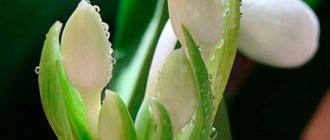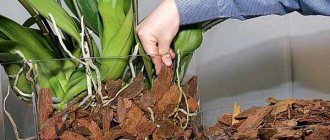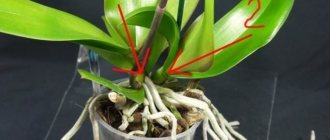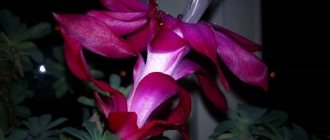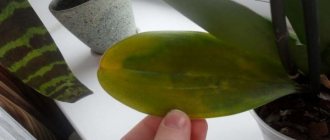Among people who grow indoor plants, the question of how to make an orchid produce a peduncle is a common one. So, the problem that a given flower rarely or even stops blooming occurs quite often. This is often due to improper growing conditions for orchids. Thus, if certain rules are followed, it becomes possible to influence the development of the peduncle.
What is a flower shoot?
Peduncle - a shoot (arrow) running upward from the base of the plant on which flowers are formed, or, in a narrower sense, a segment of the plant stem on which flowers are formed.
The peduncle is very similar to the root of an orchid, so often inexperienced gardeners make irreparable mistakes in caring for the plant, which can lead to the fading or death of the peduncle. What are the main differences between a peduncle and a root?
- The shape of the root is round, and the peduncle is cone-shaped.
- The flowering shoot appears only from the leaf axil.
- The arrow appears above the previous flowering site.
- The presence of irregularities on the peduncle - buds - is mandatory.
Most often, the orchid produces flower stalks in the fall, when the temperature differences between day and night are large: from +25C to +15C. The average period for the formation of a flower arrow is 2 – 3 months (from the moment of appearance to the stage of the formed peduncle). If the grower creates comfortable conditions for the plant, this process can be accelerated. At the same time, this will guarantee that the home beauty will definitely bloom.
How to water orchids to bloom
Watering is the main agrotechnical activity when caring for plants. Proper hydration will help bring flowering closer.
You need to water the flower with warm, settled water. You need to pour water carefully so as not to flood the outlet.
In general, watering an orchid should imitate the weather in the tropics. Therefore, sometimes it is useful to take a warm shower. But there is no need to be too zealous, since abundant watering does not encourage the orchid to release a peduncle.
If the arrow stubbornly does not want to appear, then watering should be reduced, or even stopped altogether for a while. After the appearance of the peduncle, watering is restored gradually. There is no need to pour a lot of water at once.
How important is flowering?
The peduncle is the most important part of the orchid. Some florists call it the “heart” of the plant. It is this that provides all the beauty of the orchid, since flowers form on it. As you know from biology lessons, a flower is a means by which a plant attracts insects for pollination, that is, for procreation. As confirmation of this, it is on the peduncles that babies appear, which can then be easily rooted and a new plant can be obtained (read about how to grow a baby on an orchid peduncle here).
While the orchid's peduncle is growing, the plant should under no circumstances be replanted (we talked in detail about caring for the orchid before and during flowering here)!
Description of appearance and meaning
The peduncle is a thick dark green twig with a smooth surface and a pointed tip. Along its entire length, equidistant from each other, there are several scales, from which flowers subsequently appear. In young plants, these branches are erect, but over time they can branch, acquiring different shapes.
An orchid produces a flower arrow several times during its entire life. In some cases, it persists for several years, producing new shoots and flowers. But sometimes it is limited to only one flowering and then dries out. In addition to flowers, babies can also form on peduncles.
The peduncle is a thick dark green twig with a smooth surface
Difference from root baby
It is difficult even for experienced flower growers to distinguish short flower arrows from basal children at the formation stage. The similar shape, color and presence of scales are usually misleading. Also common are the places of growth - leaf sinuses. You can recognize a baby by the following signs:
- there is no growth point;
- during development, the tip of the shoot becomes like an open beak;
- the scales are larger and eventually turn into leaves;
- are formed only in phalaenopsis over 6 years of age.
Difference from root
If the orchid has released aerial roots, even a beginner can distinguish them from the peduncle. The root grows and looks different from the flower arrow:
- grows from a stem at the base of the plant from which leaf blades grow;
- unlike the peduncle, the tip of the root is directed downwards;
- the color is green, with a bluish tint, turning upward into light green;
- absence of scales;
- the tip of the shoot is rounded.
Difference between peduncle and root shoot
Why doesn't the plant shoot out shoots?
Important. The reasons why problems with the peduncle arise depend on what type of orchid we are talking about. Without knowing the specifics of caring for a particular orchid variety, you cannot hope for its systematic, abundant flowering!
All orchids are divided into sympoidal and monopoidal. The latter have only one growth point, the bush does not divide, it has no dormant period: vandas, phalaenopsis, ascocendes. Sympoidal ones need a period of rest, which should be properly ensured. In other words, what is good for phalaenopsis and dendrobium will be irrelevant for vanda, cymbidium, and cattleya.
Before expecting the peduncle to grow from an orchid, you need to familiarize yourself with specialized literature on the issue of creating the necessary conditions for maintaining a certain type of flower. And then it is necessary to analyze: why does the orchid not produce a peduncle, are the conditions created suitable for it, and if they are unsuitable, then what should be done? If the epiphyte does not have enough light, the watering schedule is not adjusted, the correct temperature regime is not maintained, or the plant has been fed for a long time, then flowering is out of the question.
Some florists resort to special preparations, for example, cytokinin paste. It is a phytoharmone, its main purpose is to awaken dormant buds, form shoots in the intended place, and accelerate the flowering of the plant. Another drug is succinic acid (4 tablets per 1 liter of water). Place a pot of orchid in a solution of acid and water overnight. In order for an orchid to send out a flower stalk, doing this once is not enough - a similar procedure should be carried out at least once a week.
Possible problems and ways to solve them
Lack of flowering is not the only problem that orchid owners face. Once the phalaenopsis has formed a peduncle, it needs to be cared for more carefully. However, the reason is not always hidden in care.
Emergence from the growth point
Often a peduncle appears from a growing point on old plants that have bloomed frequently. The cause may also be a change in environment, microclimate or other stress. In this case, nothing can be done. It is necessary to continue to care for the flower as before, watching the arrow. Sometimes it happens that she still gives birth to ovaries or children.
The flowering shoot is broken
Some houseplant owners try to glue two parts of a damaged shoot together with tape. However, this is strictly forbidden, as the orchid will begin to dry out and may die. The only correct action is to cut the flower stem to the nearest bud, and treat the cut areas with activated carbon or cinnamon.
Absent at all
Sometimes it happens that the plant does not produce a peduncle at all.
You can force an orchid to shoot flowers with a little stress.
To do this, just move the pot with the plant to a darker place, water less often, and lower the ambient temperature by a few degrees. This method is great for phalaenopsis that have not bloomed for more than a year.
What if there is no escape or it is frozen?
In order to find out why the arrow is not growing, you first need to make sure that the plant is healthy. Perhaps the reason lies in some kind of disease. And, of course, it is worth analyzing whether all conditions for caring for the orchid that has released a peduncle are provided. If not, then you must do everything possible to ensure that they are met.
In order for the released arrow to bloom, certain requirements must be met:
- Lighting. Orchid loves a lot of diffused light. The daylight hours for the arrow to emerge must be at least 12 hours, otherwise this can lead to the peduncle fading. The best place is south-east or south-west windows.
- Temperature. Orchid is a tropical plant that loves warmth. It feels comfortable at +25C, but the night temperature should be an order of magnitude lower: the difference between day and night temperatures should be about 5C.
- Watering. The general rule for watering all orchids remains in force: as the soil dries.
- Humidity. We should not forget about systematically spraying the plant with warm, settled water, while not forgetting about watering. However, direct impact on the plant can also be destructive, so experienced gardeners advise “enveloping” the orchid with water dust: placing the epiphyte in the center of a group of other plants and spraying them.
- Feeding. Important elements for the flower during the shoot season are phosphorus and potassium. It is better to fertilize the plant with special fertilizers for orchids, purchased in a store (for example, Agricola), 1 - 2 times a month until the period of active flowering.
Actions after flowering is completed
When the flowering period ends, caring for the flower depends on the condition of the flower stem. If the shoot turns yellow and shows signs of drying, it is cut off at the very base. The resulting wound is sprinkled with crushed charcoal or ground cinnamon to prevent infection. You can use chalk for the same purpose.
When the stem itself is green and the apical bud has dried up, the stem is shortened. The cut is made slightly above the first living bud. Exposed fabrics are treated with cinnamon, charcoal or chalk for disinfection.
If there are no signs of wilting or drying on the stem, it stands green, with healthy buds. After the end of the dormant period, buds will again form on such a stem and flowers will bloom. Therefore, you don't need to do anything with it.
What to do if there are no buds?
Many orchid lovers complain that their beauties “sit” in place, not pleasing with their blooms for several years. What needs to be done in such a situation for the plant to shoot? To begin with, just try to move the flower to a new place. If it doesn’t help, then there are several options for “shock therapy”, which are strongly recommended by experienced florists.
Temperature changes
- Move the flower with the pot to a place where there is a temperature difference of 5C - 7C: it should be cool at night, warm during the day. The best place is a balcony, veranda.
- It is imperative to check for drafts, as the plant does not tolerate them and may die.
Shading and reducing humidity
- Move the container with the epiphyte to a darker place than the one to which it is accustomed.
- Reduce as much as possible and sometimes completely stop watering the plant, giving it a kind of “drought.”
- After 1.5 -2.5 weeks, carry out the first moderate watering.
Reducing the frequency of watering
Reduce watering the orchid by half: for example, if watering was carried out once every 5 days, then you need to start watering the plant once every 10 days.- Between dry intervals, moderate watering with boiled water at room temperature is recommended.
- You cannot spray the plant at this time or moisten the substrate with a spray bottle.
It is unacceptable to use several techniques at the same time, as this can lead to the death of the flower!
Factors affecting flowering
Sooner or later the plant fades and does not always begin to bloom again. So why does the tropical beauty refuse to bloom:
- The plant was overfed. In order to sell an orchid faster, farms use fertilizers and stimulants that cause flowering. At home, this is not possible due to the lack of these drugs on the market. But even if they were, their constant use will lead to the death of the flower in the future;
Uncontrolled feeding can lead to the death of the orchid. - The maintenance of the flower does not correspond to optimal conditions . For each orchid tribe, there are certain conditions under which plants develop and bloom well. First of all, this is due to their growing environment in their homeland. Orchids can partially adapt to apartment conditions, but there is a limit to everything;
- The orchid has not reached flowering age. Recently, when traveling abroad, not only to tropical countries, people are tempted by the luxurious blooms of tropical beauties, buy them, bring them home, sometimes not always legally. If the flowers are in a flask, it is clear that there is no point in waiting for flowering next year. Even if a plant looks quite mature, this does not mean that it has reached flowering age. Moreover, he needs to adapt to new conditions;
- The plant is damaged by pests or is sick. And this is the saddest thing. Therefore, when bringing a new resident into an apartment, he must be treated with an insecticide and fungicide;
- The owner does not know under what conditions this type of orchid blooms.
Getting multiple stems at home
The number of flower stalks on an orchid directly depends on the genetic characteristics of the species that was acquired. An important role is played by such factors as the age of the plant, the power of its root system, the quantity and quality of lighting, regularity of watering, and compliance with the optimal temperature regime.
Provided that all requirements for the care and maintenance of the orchid are met, you can try to increase the number of flower stalks as follows:
- After flowering, cut off old flower stalks (making sure they are completely dry).
- Treat leaves and substrate with fungicide.
- Feed the plant with specialized fertilizers for orchids.
After the orchid peduncle dries to the very base, it should be trimmed. To do this you will need sharp scissors or pruning shears and activated carbon. Using a sharp, clean tool, cut off the dried peduncle, not reaching two centimeters to the surface of the substrate. The cut area is treated with crushed activated carbon.
Some florists advise: not cut off the peduncle completely, but to the very top “dormant” bud, since a lateral arrow may begin to develop from it, and a second shoot may appear from the axil of the leaves. In this way it will be possible to obtain a plant with two peduncles.
How to care for the crop?
When there is no arrow
- It is necessary to provide diffused lighting, and it must fully nourish the plant. You can also move the vase with phalaenopsis to a brighter place. Good lighting is the key to the proper development of sprouts, which will later lead to beautiful and delicate buds.
- Water your orchid regularly. However, this should be done only after the top layer of soil has dried. If this method does not help, try stimulating the plant's growth by taking a break from watering. Usually the break should not exceed 10 days, after which the phalaenopsis should be watered using a shower. This method will allow the orchid to rest a little.
- Provide the flower with a flow of fresh air. It is best to place the vase with the plant in a room with good ventilation. At the same time, you should make sure that the orchid is not in a draft.
- Air humidification is an important part of the process, since dry air simply will not allow the flower stalk to appear.
- The orchid needs constant and regular feeding with fertilizers. It is best to use fertilizers from trusted manufacturers and strictly follow the instructions on the packaging.
When the flower let her go
- When the arrow appears in winter, autumn or spring, the flower can be safely placed on the south side of the room. The sun's rays are not yet intense enough to burn the tender leaves.
- It is worth reducing the watering regime, but at the same time carefully watching the plant’s reaction. If you notice that your flower is starting to wilt, immediately return to your previous watering schedule.
- After the bud appears, it will be necessary to reduce the intensity of feeding the orchid. After the bud grows and gets stronger, it is necessary to stop feeding, otherwise the plant will become oversaturated with fertilizers.
How to direct the arrows to grow upward?
Wait until the arrow reaches a length of 15 - 20 cm. While it is green, it is very flexible and can easily change the direction of its growth.- The grown shoot must be fixed in a vertical position using a support in the pot and a special clothespin (elastic band, hairpin, etc.).
- If there is a risk of injury to the peduncle or even breaking it, then fixation can be carried out gradually. In order to bring the peduncle as close as possible to the support, it is tied with an elastic band, rope, tape or bandage to the holder, gradually reducing the distance between them over time.
We suggest watching a video on how to properly secure a peduncle so that it begins to grow upward:
Preventing problems
It should be noted that in their natural environment - the tropics - orchids grow on trees from which their flower stalks hang under the weight of buds and flowers. Therefore, the growth of shoots not vertically upward, but horizontally is a natural process for this plant, inherent in nature. The only way to prevent such a situation at home is to constantly turn the orchid pot as the peduncle deviates to the side. It will reach towards the light, thereby aligning itself.
As for the problems of “freezing” of the growth of the peduncle or the reluctance of the orchid to bloom at all, there is only one recommendation: strictly adhere to the requirements for the maintenance and care of a certain type of orchid.
Caring for an orchid is a labor-intensive process. Difficulties can arise at every step. Only perseverance, determination, and attentiveness of the gardener will help him achieve the main goal when growing an orchid - admiring the beauty of the flower for a long time.
When do orchids usually bloom (time)
Each plant has its own life cycle. The implication is that the flowering and dormant periods occur at approximately the same time. Orchid in this case is no exception.
Despite the fact that the flower grows at home, it still follows the vegetation mechanism laid down by nature.
Orchid blooms in autumn. At this time, in nature there are strong fluctuations between day and night temperatures (up to 10 degrees, from 15 to 25).
On average, a peduncle is formed within 60-90 days, but this period can be significantly accelerated if proper conditions are created.
